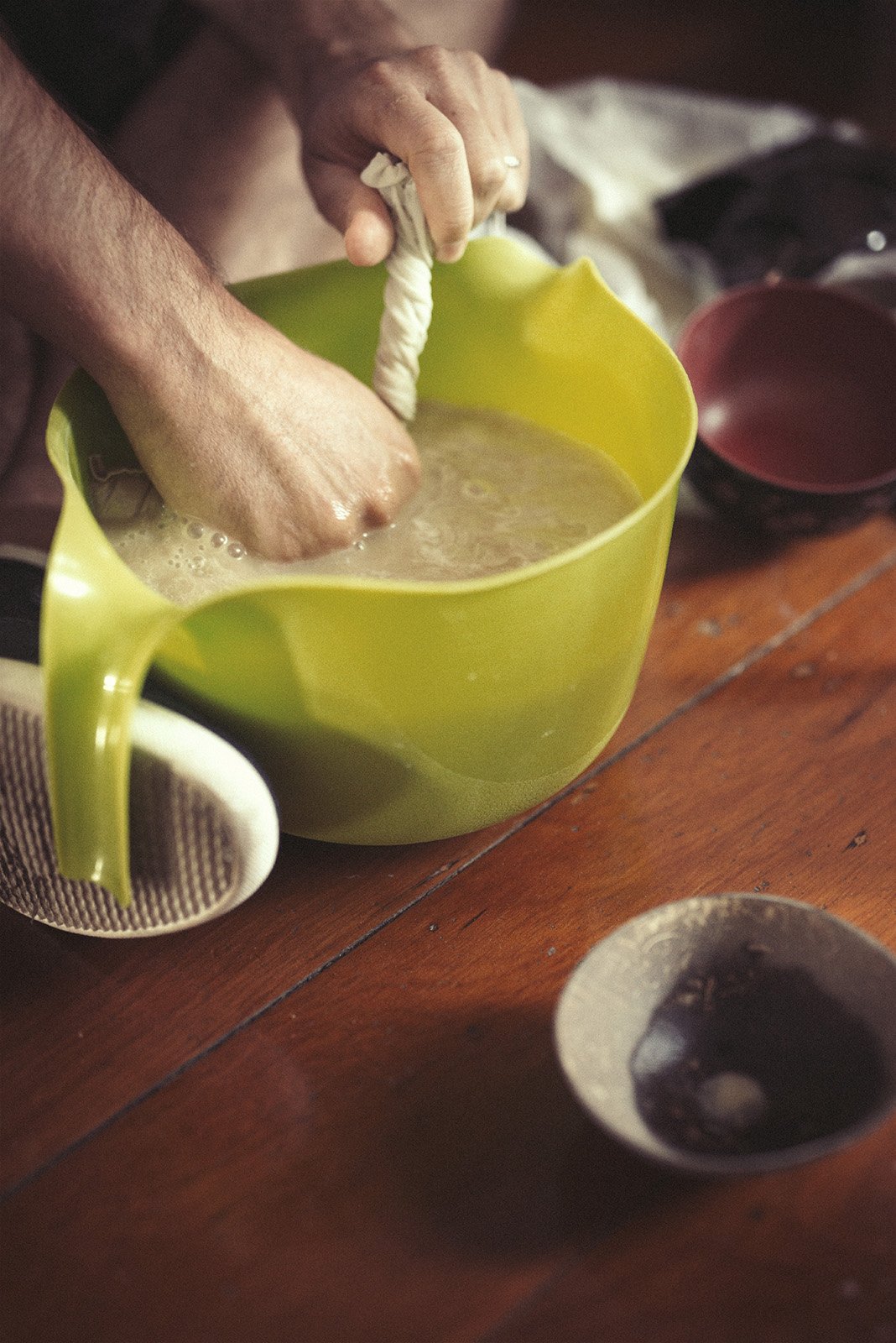Kneading kava? The science behind efficient traditional kava preparation (research by Root & Pestle)
Traditional kava: why bother when there’s instant kava?
While many people (especially those new to kava) value the convenience and ease of of instant kava, more experienced drinkers tend to gravitate towards traditional grind form, and they patiently prepare their kava the “old way”. There’s just something inherently pleasant, relaxing or even “grounding” in the traditional kava preparation. It takes a bit of extra time, it takes some patience, it requires some focused attention. Then there is the stronger, fresher aroma, the thicker, creamier body, the fuller, more complex taste of the drink.
In many ways the difference between traditional grind kava and instant kava is like the difference between preparing coffee from whole beans vs drinking instant coffee. Both forms “do the job” in terms of delivering of active ingredients and key taste characteristics, preparing coffee or kava the traditional way offers a richer experience, especially in a social context. Just like it’s true for instant coffee, the process of making instant kava inevitably results in some loss of the fresh aroma, taste and texture of kava. As you know, our goal has always been to offer dry kava that is as close to freshly harvested green plants as possible (and we keep inching closer and close to this ideal while being already pretty damn close). This is how kava has been consumed for millenia and drinking it in a form that is as closest as physically possible to its authentic fresh form seems to produce the best, most wholesome and richest experience.
Just to be clear though, the difference between our instants and traditional kava isn’t that big (and with further refinements to manufacturing and drying processes it may continue to shrink). Instant kava is definetely a fantastic option in various contexts and for various people. We are very proud of the instant kava we offer, especially our single cultivar instant kava range. While perhaps not as aromatic and rich as our traditional kavas, our instants are just as effective and encapsulate the essence of respective cultivars’ effect profiles. We are also confident that our instant kava is far closer to fresh kava experience than virtually any other dry kava on the market.
Instant kava is a great way to begin your kava journey, to try different varieties, to experiment with dosage, styles of drinking, perhaps even combining kava with some flavours (e.g. coconut water, fresh juices). Furthermore, not everyone has the time or even ability to knead a strainer bag for 5-10 mintues and we are very happy to be able to offer a more convenient option. Instant kava is also an amazing option when you travel, or want to enjoy kava in contexts where preparing it traditionally is simply not practical. So, we definitely think instant kava is a great option for both new and experienced drinkers. We just want to highlight the difference and be honest about some trade-offs, and perhaps encourage those who have been enjoying instant kava to venture into the world of traditional kava forms if they are curious about broadening their kava experience.
Fresh kava prepared in a traditional way using modern tools (cotton bag and stainless steel bowl) in Vanuatu
Making the most out of your traditional kava preparation: guest post by Root and Pestle
Now, with that explanation out of the way, we would like to focus on the key topic of the day, i.e. the science behind traditional kava preparation, or, more specifically, what does science say about how to make the most out of your traditional preparation. People often ask us if adding x, y, z can help them to “extract” more from their traditional grind powder, what water temperature works best, of if they should do multiple “washes” (i.e. knead the same powder multiple times in fresh batches of water) to get “more bang for their buck”. Our friends at Root and Pestle in Vanuatu have recently acquired some new equipment for their world-class lab, and have decided to start looking at some of these questions more seriously. Today we are happy to share the results of their study of the question of “multiple washes”. There’s a lot of inaccurate info about the effectiveness of traditional preparation method (with some online sources claiming that only as little as 10% kavalactones getting released), so this study definitely addresses some of these claims. Have a read to read a bit more about how effective different “washes” can be and how our friends have arrived at their answers. Our general take is that it’s not a bad idea to consider doing a small second wash and combining it with the first one, especially if you want to stretch your kava a bit further or prepare it for a large group of people, but we personally think doing more washes is a bit of an overkill. But you can decide for yourself by reading the report prepared by our friends at Root and Pestle below:
TLDR: On average, 51.16% of available kavalactones were extracted by us in the first squeeze. A second wash pulled out another 14.17%. The third squeeze gave us 6.25%, the fourth 4.32%, the fifth 3.12%, the 6th 2.16%, the 7th 1.68%, and the eighth 1.44%, for a total extraction efficiency of 84.31% after 8 sequential squeezes of the same kava, using fresh water for each cycle. These results were based on 5-minute cycles of automated squeezing of 62.5 g of traditional kava powder in an R&P strainer bag in 1 L of 28 °C water. More details below:
Multiple Washes: New Insights into the Kava Squeeze Revealed by Root & Pestle R&D
There have been countless questions (and tips) about how to maximise the efficiency of an aqueous extraction of kava, or in other words – how to optimise the squeeze.
The compounds in kava powder aren't fully transferred into the beverage during squeezing, but how do different variables affect strength and chemotype, and how much of the kavalactone content of traditional kava powder ends up in the prepared drink? Are some kavalactones extracted more easily than others? Do kavalactone ratios change depending on the squeeze technique, leading to different subjective effects from the same kava powder?
Over the past few months, we’ve invested a small fortune and untold hours conducting a wide range of experiments at our state-of-the-art facility in Vanuatu. Our goal: to separate myths from facts and provide empirical answers to kava squeeze-related questions that have, until now, been largely answered only anecdotally. Extensive data analysis is ongoing, and we’ll report our findings as they become available, starting in this post.
Our squeeze investigations focused is on quantitative analysis, with a few organoleptic observations along the way. The subjective experience is a significant part of kava - Just because a method extracts more kavalactones doesn't mean you'll prefer the resulting kava or the experience. Most agree that hotter temperatures negatively impact taste, and some don't want to spend ages preparing their kava. Preferences vary between tradition and technology.
This process has limitations. Although our lab is at the cutting-edge in kava, we’re fairly small in the grand scheme of scientific research. We didn’t probe deeply into bioavailability or other pharmacological attributes during this process - We simply prepared hundreds of beverages under different conditions and quantified their kavalactone concentrations. We haven’t submitted our results for peer review or publication in technical journals - We want to contribute directly to the knowledgebase of kava lovers.
Our specialised R&D team, with extensive technical and scientific backgrounds and substantial experience in kava, employed advanced laboratory equipment and techniques to obtain these results, however, nobody can tell you the best way to prepare your kava; We can only reveal how different methods affect kavalactone content and ratios. You’ll need to determine what works best for you through personal experimentation, as taste is subjective, as are the desired effects. We’re here to share our findings, not dictate your preparation method. If you find our insights useful, that’s great. If not, please continue making kava the way you prefer; there is no single “best” method.
So what did we discover about putting the same strainer bag of kava through sequential squeezes?
Compared to the total we were able to pull out of the kava powder using the gold standard for kavalactone extraction, a Thermo Scientific Dionex™ ASE™ 350 Accelerated Solvent Extractor, running organic solvents at high temperatures and pressures, with long hold times and large rinse volumes, here’s how much of the combined 6 major kavalactones we were able to extract from the same kava powder on each “normal squeeze” in water:
Squeeze #1) 51.16%
Squeeze #2) 14.17%
Squeeze #3) 6.25%
Squeeze #4) 4.32%
Squeeze # 5) 3.12%
Squeeze #6) 2.16%
Squeeze #7) 1.68%
Squeeze #8) 1.44%
These 8 successive squeezes of the same kava yielded a total kavalactone extraction efficiency of 84.31%.
We have seen extraction efficiencies reported as low as only 15% of the available kavalactones, and there are numerous factors that affect this beyond what we’re exploring here. One extremely important (but often overlooked) example isn’t just how the kava is squeezed, but how it was processed prior to packaging; This may be surprising to some, but factors such as the way kava is peeled, chopped, dried, and ground can influence how easy it is to pull kavalactones out of it, so even if you buy two kava powders which test with similar kavalactone content, they may not extract the same at home – something that we have learned through years of experience.
Nevertheless, there is no doubt that the best portion of what is available is coming out in the first squeeze, but there may be some value in doing further washes if you’re looking to wring your kava out for everything its worth.
It’s also important to realise that the kava produced from our sequential washes was much more dilute than what was obtained from a single squeeze; Even though we continued to extract kavalactones with subsequent washes, we ended up with much more liquid too. Kava derived from a single squeeze was of course more authentically similar to kava served in nakamals throughout Vanuatu, with it’s creamy and rich texture, but performing a second squeeze and combining it with the first resulted in a milder version which you may still find enjoyable. Beyond this, we found it too watered down.
The extraction efficiency of each kavalactone under these conditions was not identical to one another, but the chemotype of the prepared beverages closely reflected the chemotype of the powder, especially in the first 2 squeeze cycles. Subsequent extractions saw the relative amounts of yangonin decrease, while the relative amounts of desmethoxyyangonin, methysticin, and dihydromethysticin slightly increased. The relative amount of flavokavains decreased substantially in subsequent washes, and after 5 washes we could no longer quantify the very small amount of extracted flavokavains. The relative amounts of kavain and dihydrokavain, the two most abundant kavalactones in our powder, remained fairly consistent from wash to wash.
Root and Pestle’s laboratory
For those who are interested in more technical details about our methodology and instrumentation:
For consistency in technique, we used an automated system (essentially a glorified portable washing machine) to gently squeeze our kava in 28 °C (82.4°F) water, for 5 minutes per squeeze cycle, followed by strong hand-wringing of the strainer bag between each successive squeeze.
We used 62.5 grams (2.20462 ounces, for our American friends) of kava in 1 L (1.05669 US liquid quarts) of water, collecting a sample and draining the liquid after each squeeze cycle, then cleaning our squeeze machine, returning to it the wrung-out strainer bag with the partially extracted kava powder still inside, then pouring in 1 L of fresh water for each subsequent squeeze (for a total of 8 liters of prepared kava, which made for some seriously dilute drinks by the end of our experiment).
We conducted our experiments using a traditional grind kava powder, derived from a blend of fresh green Vanuatu noble cultivars with a net chemotype of 423165 and containing 6.661% kavalactone content by weight (including the moisture content of the powder). Note that we report our kavalactone concentrations based upon the powder as packaged, rather than on the dried weight. Although this may be somewhat uncommon in the industry and results in reporting lower kavalactone levels, we feel it is a more accurate reflection of the powder as used, and it makes it easier for people to understand what they’re really working with.
Almost all water has impurities (or additives such as chlorine), and these can alter both the kavalactone content and the taste of the finished beverage. When we prepare kava for ourselves to drink, we usually use filtered rainwater, but we were looking to minimise variables in these tests, so our experiments were conducted using ultrapure water (measured at 18.2 MΩ of resistance).
Our samples were weighed to within 100 µg (a microgram is one millionth of a gram) on analytical balances calibrated with certified class OIML E2 weights with uncertainty +/- 0.000016 g (NATA accredited for compliance with ISO/IEC 17025, by laboratory No.3279), and all of the other instrumentation used for these experiments was also modern, fit for purpose, and well cared for, even down to our pipettes, which are serviced and calibrated by Eppendorf to ISO 8655-6:2022.
Samples from each squeeze were collected, lyophilised, then reconstituted in organic solvents matching the carrier for our analytical reference standards, filtered, and prepared for injection into our UHPLC system.
Kavalactone concentrations were analysed by qualified experts on our Thermo Scientific Vanquish Horizon Ultra-High-Performance Liquid-Chromatography system, comprised of VF-A10-A Split Sampler, VF-P10-A Binary Pump, VFD11-A Diode Array Detector, and VH-C10-A Column Compartment, fitted with a 200 x 2.1 mm Hypersil GOLD, 1.9 µm particle size column, running the same instrument and processing methods (with Chromeleon 7.3.2 software) we use when we submit reports destined for the FDA and other regulatory agencies.
UV detection was set at 362, 341, 246, and 218 nm, with peak identification assisted by elution time and spectrum matching, and relative quantification calculations were based on peak areas at 246 nm.
Correlation coefficients for all identified compounds were greater than 99.995% on a 20-point calibration curve derived by serial dilution of ampoules of Cerilliant certified analytical reference standards. Our lower and upper confidence probabilities were 99.5%.








Leave a comment
This site is protected by hCaptcha and the hCaptcha Privacy Policy and Terms of Service apply.